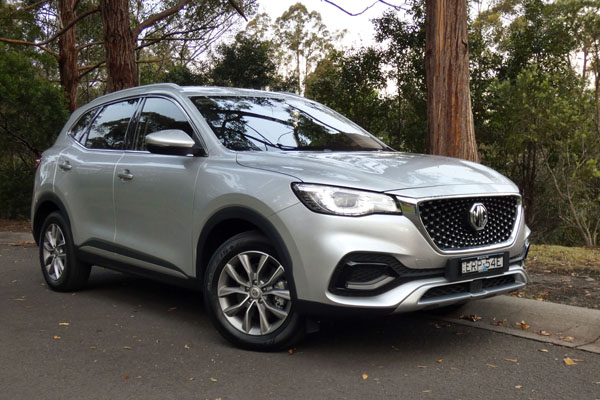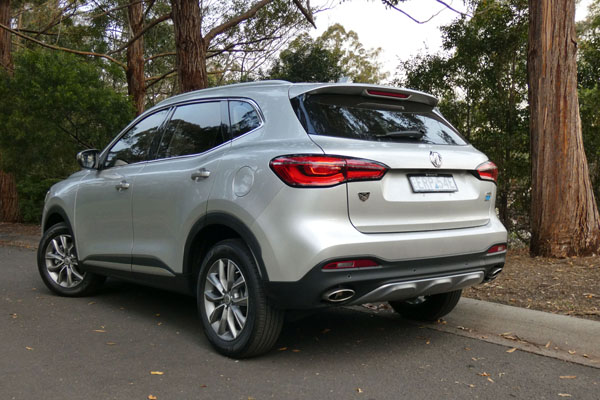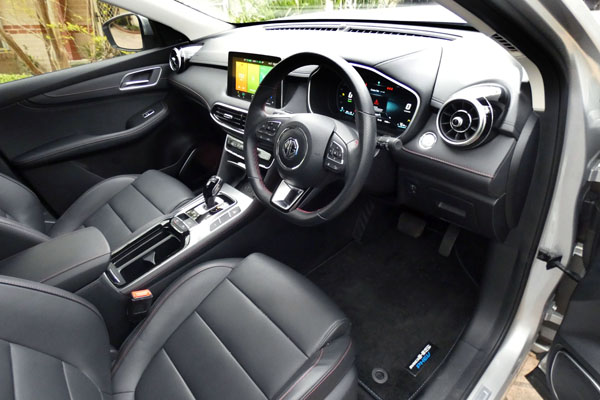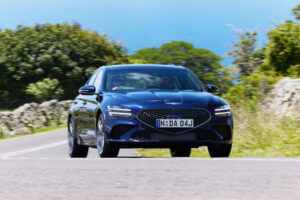
Can it really be four years since I last drove an MG?
It was the compact ZS SUV and being quite new back then, there was quite a bit of
interest in the car.
Once renowned for its two-seat open-topped sports cars, MG is now owned by the huge
Chinese state-owned SAIC Group and produces two SUVs and a cheapo hatch — the HS,
ZS and MG3.
Much of the current interest stems from the fact the two SUVs are offered with electrified
powertrains: HS is a plug-in hybrid while the ZS is available as a fully electric model.
STYLING
There’s just three colours from which to choose: red, white or silver, all of them metallics.
The styling is generic and the five-seat wagon could easily be mistaken for any one of the
many medium-sized SUVs that have flooded the Australian market.
We’re looking at the confusingly named MG HS +EV.
Once known as the HS PHEV (it is after all a plug-in hybrid), it comes in Excite and
Essence grades, priced at $48,690 and $51,690 driveaway.
The price is not that much less than mainstream offerings from the Japanese, principally
Toyota’s best-selling RAV4 Hybrid, which although it is not a plug-in, obviously fits the bill
for most people.

For many, that will be the end of the story, but there’s much to like about the MG HS +EV.
Our test car was the entry level Excite. Standard kit includes artificial leather, leather
trimmed steering wheel, two-zone climate air, keyless entry and push button start, heated
front seats and six-way power adjust driver’s seat (passenger seat manual adjust) and
angle adjustment for the rear seats.
There are also 17-inch alloys, a 12.3-inch fully digital instrument cluster, LED daylight
driving lights, auto lights and wipers and auto dimming rear view mirror and cooled console
box.
For another $3000 the Essence adds 18-inch alloys, panoramic sunroof and two-tone
leather insert sports seats at front.
There’s also four-way power adjustment for the front passenger seat, a 360-degree
camera, LED headlights, LED ambient lighting, fog lights, heated door mirrors and a power
operated tailgate.
Sounds like $3000 well spent.

INFOTAINMENT
The infotainment system consists of a 10.1-inch touchscreen six-speaker ‘3D surround’
audio, with Bluetooth, built-in navigation, AM/FM radio (no DAB+), Apple CarPlay or
Android Auto plus a 12v power socket and four USB and ports — two at the front and two
at the rear.
ENGINES / TRANSMISSIONS
Power comes from a 1.5-litre four-cylinder, turbo petrol engine, together with a 16.6kWh
battery pack and 90kW electric motor that deliver an impressive combined output of
189kW and 370Nm.
It is mated to a 10-speed EDU II automatic gearbox, which consists of six-speed auto for
the internal combustion engine and four-speed electronic drive unit, with drive to the front
wheels.
SAFETY
The +EV is yet to receive a crash rating. Standard safety includes six airbags, a reversing
camera and rear parking sensors.
Also, standard is the MG Pilot package that adds automatic emergency braking
(pedestrians up to 64km/h and vehicles to 150km/h), adaptive cruise control, forward
collision warning, lane departure warning, traffic jam assist, intelligent cruise assist, blind
spot warning, rear cross traffic alert, intelligent headlight control and speed assistance
system.
DRIVING
There’s no facility to change gears manually, nor are any drive modes offered apart from
EV mode.
You can plug it in and charge the battery or drive it as a self-charging hybrid like a Prius.
The latter mode uses energy recovered from braking to partially recharge the battery pack
as you go.
It takes premium 95 unleaded and charging with a standard power point takes about
seven hours using a standard 10A power point.
The difference is that with a fully charged battery you can drive up to 63km under electric
power alone, perhaps enough to get you to and from work.
Two fuel consumption figures are provided:
a combined figure of 1.7L/100km using a combination of petrol and electric power and a
claimed figure 5.8L/100km for the petrol engine alone
Like most plug-in hybrids it seems like a lot of hoo-haa for an extremely limited electric
range, which in hindsight might explain why Toyota baulked at offering the plug-in version
of its Prius.
The only way you can achieve the claimed 1.7/l100km is to stop the car every 100km and
fully recharge the battery before heading off again.
Not really doable, hah?
HS +EV is a good size, with large comfortable seats, plenty of rear legroom and air vents
for back seat passengers.
The boot is shallow but offers a reasonable 451 litres rear seats up and 1275 litres with the
seat backs folded.
The Type 2 charge cable is stored under the boot floor where it doesn’t get in the way, but
also leaves no room for a spare wheel (a reinflation kit is provided).
With 189kW of power and instant torque from the electric motor, the HS +EV gets moving
fairly briskly.
The front wheels have a tendency to spin and the dash from 0-100km/h takes a rapid 6.9
seconds.
Taking a softly, softly approach, the electric motor doesn’t kick until about 30km/h.
Hitting the accelerator hard sees the car surge off the mark, that is after a full second of
thought.
But the speed drops back twice significantly with transmission changes before it reaches
110km/h and beyond.
Ride quality is generally good but can be brittle at times, and the front wheels broke
traction at least twice when it encountered irregularities in the road. The front hopped a full
foot right when we encountered a bump mid-corner at speed.
The cabin is bright and airy but could do with some shading across the top of the
windscreen to keep out the hot afternoon sun.
There’s also a big blind spot created by the combination of the rear vision mirror and
sensing unit above, preventing a clear line of sight through corners.
For the most part, however, it’s a comfortable, easy car to drive that doesn’t use much fuel,
even if you opt not to charge the battery.
We were using 6.4L/100km after 300km.
The steering is okay but doesn’t provide a lot of feedback and the same can be said of the
brakes which could do with more feel.
Brake energy regeneration occurs when you lift off the accelerator. While the level of drag
cannot be adjusted, it feels about right.
The big touchscreen looks impressive and offers one of the better rear view cameras we
have seen, and while it offers CarPlay and Android Auto (both wired), you won’t find DAB
digital radio.
One side of the digital instrument cluster is devoted to the petrol engine, while the other
keeps you up to date on the battery level as well as how much assistance the electric
motor is providing — with three figures for consumption across the bottom.
Digital speed and the level of power are displayed in a really ugly, squared off font.
Another interesting feature is the Speed Assist System which is supposed to restrict the
speed of the car to the current speed limit.
Nice idea, but it couldn’t be activated.
On a final note, we were surprised when, forgetting whether we had locked the car, we
pushed the lock button again.
As a result, the horn started to sound — threatening to rouse the neighbours at midnight.
SUMMING UP
Plug-in hybrids are a great idea on paper, but the reality is that few drivers go to the
trouble of plugging in and charging their vehicle.
In fact, there have been reports of company vehicles being returned with the charging
cable untouched.
But manufacturers like plug-ins because their ultra-low fuel consumption figures reduce
their carbon footprint and help to meet strict European emissions laws.
With this in mind, you might want to weigh up the extra cost of a plug-in versus self-
charging hybrid, or even a fully electric vehicle.
While the MG HS +EV isn’t a bad car, it’s not a perfect one either — nor does it offer
significant savings over more established brands.
RATINGS:
Looks: 7/10
Performance: 7.5/10
Safety: 7.5/10
Thirst: 7.5/10
Practicality: 7/10.5
Comfort: 7.5/10
Tech: 7.5/10
Value: 7/10
Overall: 7.4/10
AT A GLANCE
MODEL RANGE
HS +EV 1.5 Plug-In Hybrid Excite 2WD: $48,690
HS +EV 1.5 Plug-In Hybrid Essence 2WD: $51,690
Note: These are drive-away prices and include all government or dealer delivery charges.
SPECIFICATIONS (MG HS +EV 1.5-litre petrol / electric plug-in hybrid five-door wagon)
ENGINE / BATTERY:
Capacity: 1.5 litres / 16.6kWh
Configuration: Plug-in hybrid
Combined Maximum Power: 189 kW
Combined Maximum Torque: 370 Nm
Fuel Type: Premium unleaded petrol
Combined Fuel Cycle (ADR 81/02): 1.7 L/100km / 5.8 L/100km
CO2 Emissions: 39 g/km
DRIVELINE:
10-speed automatic (combined engine and battery)
DIMENSIONS, WEIGHT AND CAPACITIES:
Length: 4574 mm
Wheelbase: 2720 mm
Width: 1876 mm
Height: 1685 mm
Turning Circle: Not supplied
Kerb Mass: 1775 kg
Fuel Tank Capacity: 55 litres
BRAKES:
Front: Ventilated disc
Rear: Solid disc
STANDARD WARRANTY:
Seven years / unlimited kilometres








